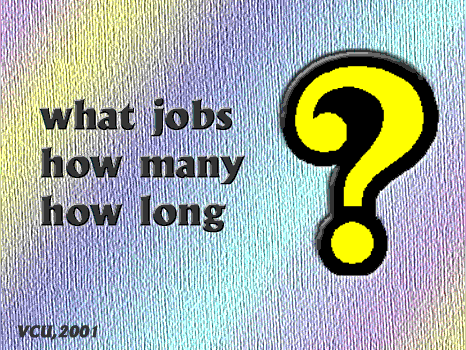
duration: 5 min 3 sec
next slide
previous slide
slide menu
Lesson 2
Situational Assessments - slide 3
What jobs?
How many?
How long?
You may be asking yourself some questions at this point that
are similar to the questions that I have posted on this next slide. Those
questions
include. What jobs should I use for situational assessments? How long should
they be? How many assessments does the person need, and what should I observe
during those assessments?
Well I’ll tell you that there are certainly some guidelines or some
thoughts that I have on that list of questions. But I don’t think
there are any hard and fast rules that relate to what jobs, how long, how
many, and what to observe. We have talked about some guidelines about identifying
what types of jobs we would like to use for situational assessments. And
that’s really reflective of what the individuals choices and interests
are that we have identified to this point in the assessment process.
Now you may be asking yourself what if the person hasn’t expressed any interests or choices, and we don’t have any place to start with this individual. I think at that point it may be helpful to identify a couple of tasks or a range of jobs that the individual potentially could have if given a job in the community. Now one way we have accomplished that is to go to a work environment where there are a number of tasks that we could target, say a local hospital, a local mall, someplace there are a variety of businesses we could work with and setup some situational assessments for the individual to participate in.
This really gets at the question,
how many assessments should the person have an opportunity to experience?
Certainly, the individual should have
more than one opportunity to participate in a situational assessment.
I tend to think at least three or four could be beneficial, particularly
if the individual doesn’t have any real concept of what it would
be like to participate or work in a community job. Or it may be beneficial
if the individual has a very specific interest, lets say has indicated
an interest in some clerical work that the individual gets to experience
several different working environments that incorporate clerical work.
So for instance maybe clerical work in a bank might be different from clerical
work in a small office, or clerical work in a very busy office where there
are a lot of people interacting with the individual.
So even if the individual is very specific about the job that he/she
wants to do, it may be beneficial to look at that same job in several
different
sort of structured environments to determine how the person would best
fit into a workplace. Now, that directly relates to how long should a
situational assessment last. I firmly believe that a situational assessment
is not
an extended work experience. We are not trying to train the individual
to perform a job. So this is not training this is an assessment, so an
assessment should be brief in nature, and should reflect the amount of
time the individual will work in that position given the opportunity
to have a job in that community. So if the person is going to work a
four-hour
day then I would like to see how the person performs in a four-hour situational
assessment. If its six hours, then a six hour assessment. If it’s
a full eight-hour workday then I would like to have the opportunity of
working with the individual within a workplace for an eight-hour workday.
Now I don’t think it needs to be a week, no I don’t think it
needs to be a month. In fact if you are getting into those kinds of experiences,
I think those opportunities are different types of opportunities and are
not situational assessments.